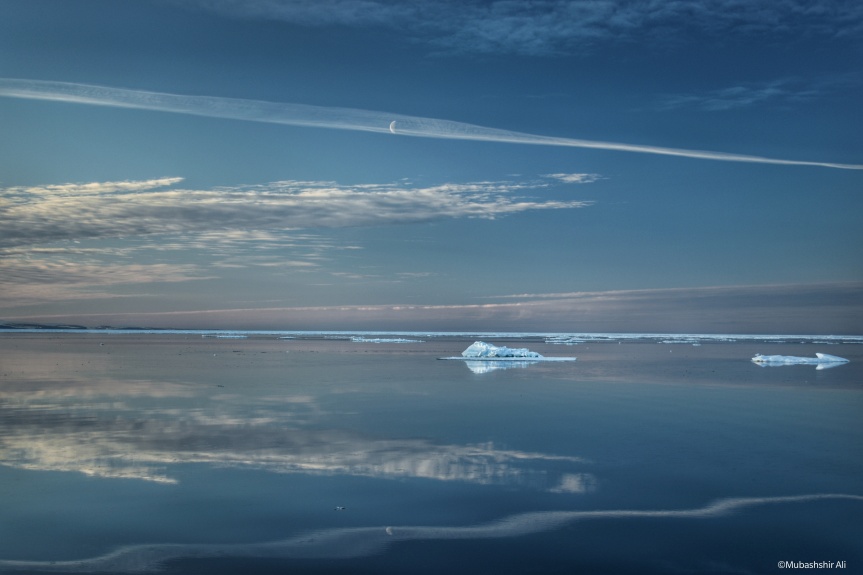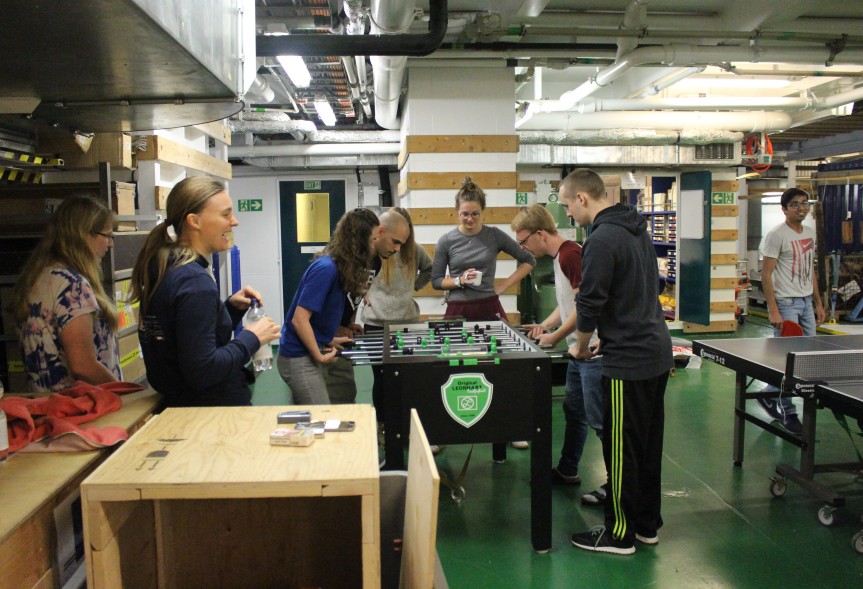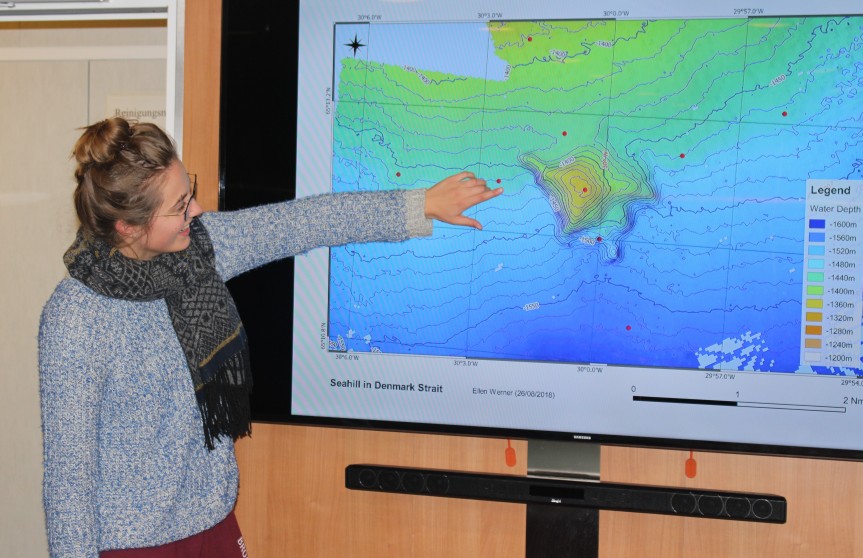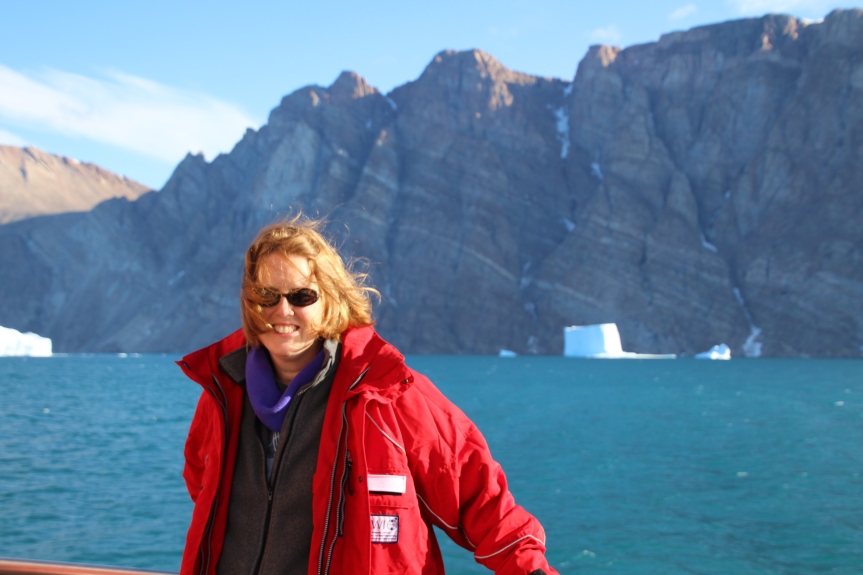
Our home for almost five weeks docked in Adventfjorden, Svalbard. Photo by Dragonfly Leathrum
Our ship arrived in Svalbard; it was wonderful to see land again, especially the mountains, glaciers and Fjords of Spitsbergen. I awoke early Tuesday, September eleven to take photos of the sunrise in Adventfjorden, a bay of Isfjorden. Gulls and the occasional fishing vessel greeted us as we sailed towards Longyearbyen. There was no room for us in port so we dropped anchor in the harbor and traveled by zodiac and rescue boat from the ship to shore to see the small, stark town.

Sunrise in Isfjorden. Photo by: Dragonfly Leathrum

Longyearbyen as seen from the R/V Maria S. Merian. Photo by: Dragonfly Leathrum
Longyearbyen is the northern most town in the world at 78º North with coal mines, a small university, and polar bears. The polar bears are an actual concern. Recently a guide from a cruise ship tour was killed as was an English Boy Scout camping close to town. There are posted road signs everywhere with warnings of polar bears. Exploring mountains and glaciers beyond tight town limits, you need a gun and a guide. I was happy to read that they use scare tactics and don’t shoot first. (The guides, not the bears) We spent an afternoon on the small main street drinking coffee and picking up a few souvenirs. I’m not a souvenir buyer by nature but this was a special circumstance. I am pretty sure that I will never have the opportunity to return, although never say never, I did not expect to show up here in the first place. Hell, I had never even heard about this town until last spring. Two mates from the ship Andreas and Andreas had fun geocaching in town which left me with time to take photos as I walked with them. Being in Longyearbyen at the end of summer it is hard to imagine the place in the winter. I was already wearing a winter coat, hat and gloves. The parking lots are filled with snowmobiles instead of cars because, like in the movie Pleasantville, all roads end at the edge of town.

Andreas W. and Andreas M. document their geocache find at the oldest building in Longyearbyen. Photo by: Dragonfly Leathrum

The main shopping street in Longyearbyen. Photo by: Dragonfly Leathrum

The glacier at the edge of town. Photo by: Dragonfly Leathrum
Returning to the ship late afternoon, we packed and cleaned our cabins and laboratories prior to our departure the next day. The wind was strong and icy and the sea choppy, so we had to put on survival suits to protect us in the small rescue boat that ferried us back to shore where a bus was waiting to bring us to the airport. The airport was super tiny and the runway super short. The pilot apologized in a few different languages for the bumpiness of the runway and explained that the pavement breaks up every summer. No big deal. The views at take-off were amazing.

A view of the Merian in the harbor from Longyearbyen. Photo by Dragonfly Leathrum

Shipmate Uli waits for his flight in the Longyearbyen International Airport terminal. This room is the only terminal/ gate. There is a room next to this of the same size with a few ticket counters and security. Photo by: Dragonfly Leathrum
Instead of heading straight back to Bremerhaven with our housemate (there is no “straight” back from Svalbard), Andreas and I decided to spend a few days in a small town south of Copenhagen in Denmark. We stayed in a quaint, dusty Airbnb in Nykøbing with a garden full of apple trees and a bicycle for Andreas to escape on to find more geocaches in a forest along the Baltic Sea. It was a beautiful Danish town founded around a 12th century medieval castle. After the Reformation the castle was the residence of widowed queens from Denmark and Germany. Many streets were permanently closed to vehicles and turned into a maze of pedestrian areas with bookstores, shops, and cafés where we spent our time. Seeing the green of the trees and grass was a bit of a shock to the eye after looking at the ocean for so long. Andreas told me that this happens to him every time he returns from long sea voyages. It was interesting to witness it for myself. On our second night the town had a DJ concert in the main square and the bass rocked the place for blocks. We found a little restaurant below street level where the occasional bass sound from the concert penetrated the thick stone walls. The bass reminded us of the engine rumble of the ship. The “land sickness” I was experiencing since leaving the ship made it feel even more so. Luckily, I only felt dizzy when sitting at a table and was fine walking and biking.

Nykobing Falster, Denmark. Photo by: Dragonfly Leathrum
It’s good to be back in Germany and each of us is trying to remember and re-establish our former routines. Our housemate, Andreas’ graduate student, is looking for an apartment. Andreas joined a competitive table tennis club and goes to practice three nights a week while I am catching up on blog writing, organizing the few thousand photos I took last month, and drawing and painting. I’m also reading a great book we found in Denmark written by Mark Twain called “The Innocents Abroad.” It describes his European travels by ship 150 years ago. It is hilarious, especially after my own European adventures.
Written by Dragonfly Leathrum 9/26/2018


































